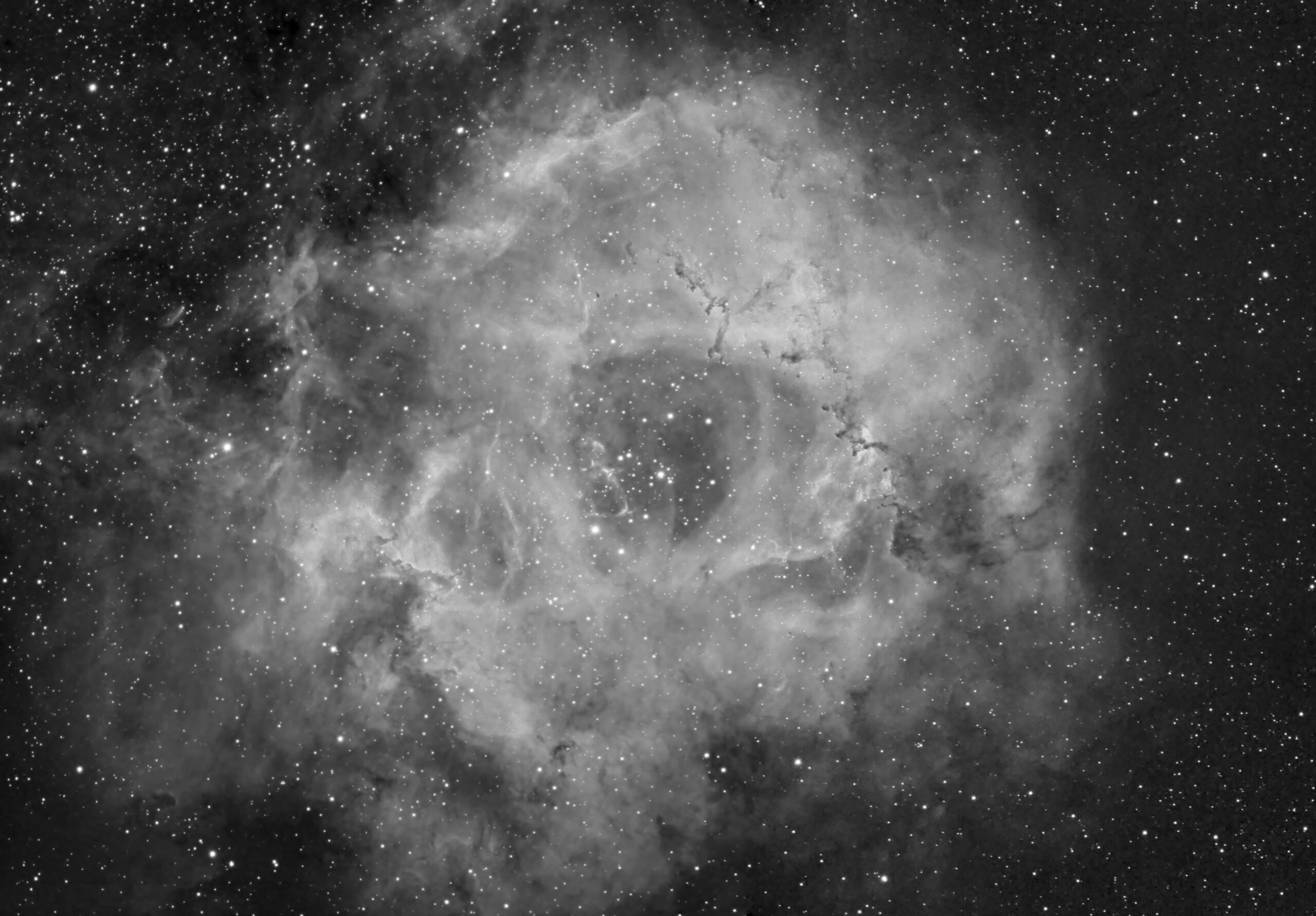Rosette Nebula in HaRGB
 Click image for full size version
Click image for full size version
January 16, 2022
This gorgeous donut is the Rosette Nebula. It’s very large and diffuse, and contains open cluster NGC 2244, which is in the darker centre of the nebula. The Rosette lies about 5,200 light years away in the constellation Monoceros, and is about 50 light years across. This gives it an apparent width about three times that of the full Moon. This nebula is a star nursery, with about 2,500 young stars estimated to be within it, and a total mass about 10,000 times the Sun’s. The young stars were formed from the gas and dust in the Rosette, and are now causing the gas to glow, absorbing invisible infrared star light and emitting it mostly as red and blue light that we can see.
 In making this image, I had to make a 2-pane mosaic for the Ha data, since the field of view couldn’t capture the entire object. The Ha mosaic is shown at left. Click the pic for full res view.
In making this image, I had to make a 2-pane mosaic for the Ha data, since the field of view couldn’t capture the entire object. The Ha mosaic is shown at left. Click the pic for full res view.
Tekkies:
Acquisition, focusing, and control of Paramount MX mount with CCD Commander and TheSkyX. Focus with Optec DirectSync motor and controller. Equipment control with PrimaLuce Labs Eagle 3 Pro computer. All pre-processing and processing in PixInsight. Acquired from my SkyShed in Guelph. Average or better transparency and seeing. Data acquired February 3 – March 7, 2021.
Luminance: Sky-Watcher Esprit 150 f/7 refractor and QHY16200M camera with Optolong 7nm H-alpha filter
Chrominance: Takahashi FSQ-106 ED IV @ f/5 and QHY367C Pro one-shot colour camera with Optolong UV/IR filter
Data Reduction and Initial Processing
Preprocessing: The WeightedBatchPreProcessing script was used to create H-alpha master frames from the mono camera and an RGB master frame from the one-shot colour camera. DrizzleIntegration (2x CFA Drizzle) was applied to the RGB set. Edge artifacts were cropped with DynamicCrop and DBE was applied to each of the three masters using Subtraction. ColourCalibration was applied to the RGB Image
Mosaic Creation for H-alpha: Masters for both H-alpha panes were cropped to remove edge artifacts and processed separately with DBE. ImageRegistration was used in mosaic/union mode to make a mosaic template. StarAlignment was used to align each pane to the template. GradientMergeMosaic was used to merge Pane 1 and Pane 2 of each channel. Edge artifacts were cropped.
Colour
Linear Noise Reduction: MultiscaleLinearTransform was used to reduce noise in the background areas. Layer settings for threshold and strength: Layer 1: 3.0, 0.5 Layer 2: 2.0, 0.35 Layer 3: 1.0, 0.2 Layer 4: 0.5, 0.1
Stretching: HistogramTransformation was applied to make a pleasing yet bright image. TGVDenoise was applied and the image was re-stretched to reset the black point.
H-alpha
Deconvolution: A star mask was made from the Luminance master to use as a Local Deringing Support Image. A stretched clone of the H-alpha image was used to make a mask selecting bright regions of the nebula for deconvolution. Deconvolution was applied (30 iterations, regularized Richardson-Lucy, ParametricPSF mode with default settings; Global dark deringing = 0.02; Global bright deringing 0.007).
Linear Noise Reduction: MultiscaleLinearTransform was used to reduce noise in the background areas, using an internal mask to protect bright stars. Layer settings for threshold and strength: Layer 1: 5.0 0.75, 1 iteration; Layer 2: 4.0, 0.6, 1 iteration, Layer 3: 3.3 0.5, 1 iteration; Layer 4: 1.0, 0.25, 1 iteration.
Stretching: HistogramTransformation was applied to make a pleasing, bright image, with background set to an intensity of approximately 0.10.
Combining H-alpha and Colour Images
H-alpha Blending: PixelMath was used to add H-alpha to the LRGB image (the target image, $T), using the following expressions for the R, G and B channels:
R: max($T[0], 1.2*Ha)
G: $T[1]
B: iif($T[0]<Ha, $T[2] + 0.06*Ha, $T[2])
Additional Processing
Nonlinear Noise Reduction: TGVDenoise was used in L*a*b* mode to reduce noise with a mask used to target the background areas and protect the stars and nebula (max. 1,000 iterations and convergence selected for both lightness and chrominance).
Contrast Enhancement: LocalHistogramEqualization was applied using an inverted star mask to protect the stars (scale 50, max contrast 1.5, strength 0.25, 1 iteration, followed by scale 150, max contrast 1.5, strength 0.35).
Sharpening: MultiscaleLinearTransform was used to sharpen Layers 2 and 3 with strengths of 0.2 and 0.13, respectively. A mask was made by subtracting a star mask from the mask used for deconvolution. This was used to limit sharpening to specific regions of the image, while avoiding sharpening the stars.
Final Steps: The DarkStructureEnhance script was applied with a strength of 0.2. Background, nebula and star brightness, contrast and saturation were adjusted in several iterations using CurvesTransformation with masks as required. ICCProfileTransformation (sRGB IEC61966-2.1; Relative Colorimetric with black point compensation) was applied prior to saving as a jpg.






Leave A Comment